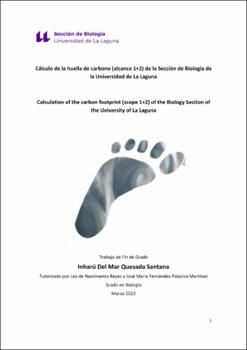Cálculo de la huella de carbono (alcance 1+2) de la Sección de Biología de la Universidad de La Laguna
Date
2023Abstract
Este trabajo tiene como objetivo medir la huella de carbono generado por las
emisiones de gases de efecto invernadero (GEI) de la Sección de Biología de la
Universidad de La Laguna (ULL) para orientar las acciones de mitigación. Las emisiones
directas (alcance 1) derivadas del consumo directo de combustible de los edificios,
instalaciones o vehículos, y la fuga de GEI de equipos, y las emisiones indirectas (alcance
2) correspondientes al consumo de electricidad generada por proveedores ajenos al emisor, asociadas a la actividad docente e investigadora del centro, se estimaron con la
calculadora de huella de carbono del Ministerio para la Transición Ecológica. La huella de carbono de la Sección de Biología en 2021 fue de 103,77 tCO2eq, de las cuales 18,71 tCO2eq corresponden a emisiones directas, siendo los desplazamientos en transporte marítimo de las actividades de máster, los que más contribuyeron (61,5%), seguido del transporte por carretera de la actividad docente de grado y máster (19,2%) y el uso de gas butano en la cafetería (19,2%). Las emisiones indirectas, 85,1 tCO2eq, generadas en su totalidad por el consumo energético suponen la mayor fuente de emisión (82,0%) de la Sección. Se valoraron las distintas opciones de mitigación propuestas por el IPCC, la Estrategia Canaria de Acción Climática y el Plan de Ahorro Energético de la ULL. La compensación de la huella de carbono requeriría plantaciones de 0,22 ha de laurisilva, 0,47 ha de pinar o 8,08 ha de tabaibal dulce, y su desarrollo hasta etapas maduras. La reducción del consumo energético y la eficiencia energética serían medidas de mitigación más eficientes a corto plazo. This work aims to measure the carbon footprint generated by greenhouse gas
(GHG) emissions from the Biology Section of the University of La Laguna (ULL) to guide
mitigation actions. Direct emissions (scope 1) derived from the direct fuel consumption
of buildings, facilities or vehicles, and GHG leakage from equipment, and indirect
emissions (scope 2) corresponding to the consumption of electricity generated by
external suppliers, associated to the teaching and research activity of the center, were
estimated with the carbon footprint calculator of the Ministry for Ecological Transition.
The carbon footprint of the Biology Section in 2021 was 103.77 tCO2eq, of which 18.71
tCO2eq correspond to direct emissions, with maritime transport from master's activities
to other islands contributing the most (61.5 %), followed by road transport for bachelor's
and master's degree teaching activities (19.2%), and the use of butane gas in the
cafeteria (19.2%). Indirect emissions, 85.1 tCO2eq, due to energy consumption,
represent the largest source of emissions (82.0%) in the Section. The different mitigation options proposed by the IPCC, the Canary Islands Climate Action Strategy and the ULL Energy Saving Plan are evaluated. Offsetting the carbon footprint required plantings of 0.22 ha of laurel forest, 0.47 ha of pine forest or 8.08 ha of tabaibal dulce, and their development to mature stages. Reducing energy consumption and energy efficiency will be more efficient mitigation measures in the short term.





